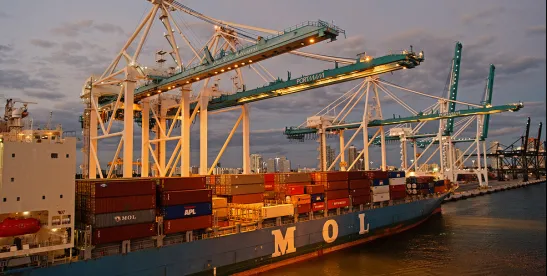Concluding its Section 301 Investigation into “China’s Targeting the Maritime, Logistics, and Shipbuilding Sectors,” the United States Trade Representative (USTR) issued an updated notice of action on April 17. USTR initially issued a proposed action to impose fees on Chinese vessels in the amount of $1 million or $1.5 million per port call. USTR issued the updated notice following President Donald Trump’s April 9 Executive Order 14269, “Restoring America’s Maritime Dominance” (90 Fed. Reg. 15635).
The updated fees will be imposed starting October 14. The fees are structured under four annexes, with Annex I and Annex II being particularly relevant to intermediaries, non-vessel-operating common carriers (NVOCCs), and freight forwarders. Each vessel will be charged only on the initial port call and cannot be charged more than five times per year.
Annex I: Chinese-Owned and Chinese-Operated Vessels
Vessels owned or operated by Chinese entities will be subject to fees based on their net tonnage. The fee starts at $50 per net ton in 2025 and will incrementally increase to $140 per net ton by 2028. Importantly, the fee is assessed at the first US port of entry, regardless of subsequent port calls within the United States.
Annex II: Chinese-Built Vessels
For vessels that are not Chinese-owned or Chinese-operated but are Chinese-built, fees are assessed based on the higher of two metrics:
- Net Tonnage: Starting at $18 per net ton and increasing to $33 per net ton over three years.
- Container-Based Fee: Starting at $120 per container and increasing to $250 per container over three years. (While the USTR was ambiguous on this point, this per-container fee is likely on a per Twenty-foot Equivalent Unit basis.)
Vessel operators are required to report the number of containers discharged at US ports or with an ultimate destination in US customs territory.
Exemptions and Fee Remissions
Certain vessels are exempt from these fees, including:
- Vessels with at least 75% US ownership.
- Small vessels under specific size thresholds.
- Vessels engaged in short sea shipping (voyages under 2,000 nautical miles).
Additionally, operators can receive fee remissions for up to three years if they order and take delivery of US-built vessels of equivalent or greater capacity within that period.
Annex III: Foreign-Built Car Carrier Vessels
For all foreign-built car carrier vessels, fees are assessed at $150 per Car Equivalent Unit capacity.
Annex IV: Liquefied Natural Gas (LNG) Vessels
One percent of vessels transporting LNG exports must be US-flagged, US-operated starting in 2028, and then in 2029, must be an increasing percentage US-built, US-flagged, and US-operated, increasing to 15% in 2047.
Annex V: Tariffs on Ship-to-Shore (STS) Cranes and Cargo-Handling Equipment from China
Finally, USTR proposed duties on STS cranes and cargo-handling equipment. Comments are due May 19.
Next Steps: Update Your Rules Tariff Terms and Conditions
To adapt to these new fees, it is crucial for freight forwarders and NVOCCs to update their rules tariff terms and conditions. By doing so, you can ensure that these fees are passed through to the appropriate parties, minimizing financial exposure and maintaining operational efficiency.




 />i
/>i

